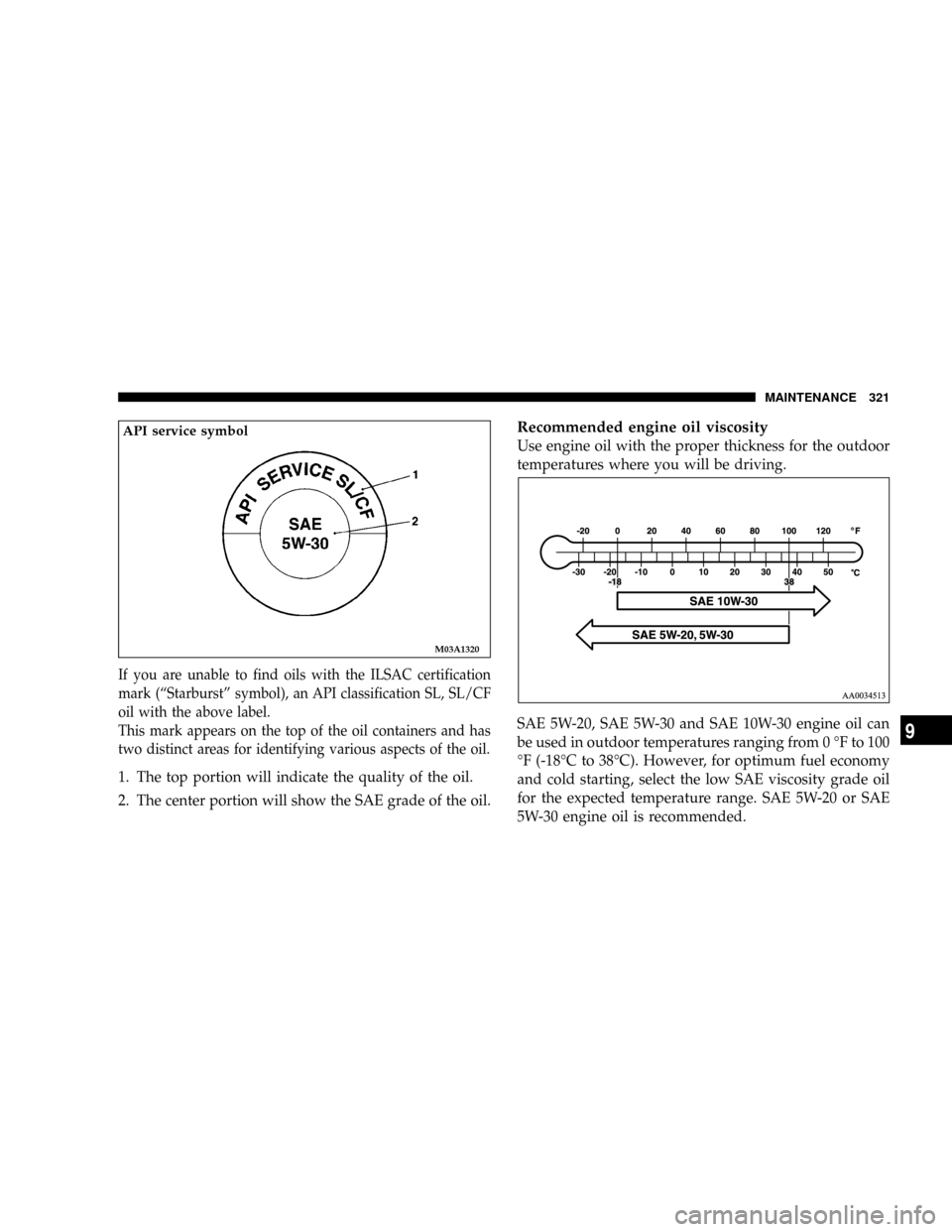2005 DODGE STRATUS COUPE oil temperature
[x] Cancel search: oil temperaturePage 105 of 396

INSTRUMENTS AND CONTROLS
CONTENTS
mInstrument cluster......................108
NMeter cluster.........................108
NIndicator and warning light package........109
NSpeedometer.........................110
NTachometer..........................110
NFuel gauge..........................111
NOdometer/Trip odometer................112
NEngine coolant temperature gauge..........113
NTurn signal indicators/hazard warning lights . . 114
NHigh beam indicator...................114
NTheft-alarm indicator...................114
NDoor-ajar warning light and chime.........114NAnti-lock braking system warning light
(if so equipped).......................115
NCruise/speed control indicator............115
NLow-fuel warning light and chime..........115
NFront fog light indicator (if so equipped).....116
NCharging system warning light............116
NOil pressure warning light...............116
NMalfunction indicator light
(SERVICE ENGINE SOON)...............117
NSupplemental Restraint System (SRS)-air bag
warning light.........................118
NBrake warning light....................119
NSeat belt reminder/warning light...........120
4
Page 204 of 396

over curbs or parking stop blocks. Always use caution
when traveling up or down sharp inclines as your
bumper may contact the road surface.
2. Maintain specified tire inflation pressures. Replace
tires before they are excessively worn.
3. If you plan to drive in another country, comply with
the vehicle registration laws and confirm the availability
of the correct fuel.
OPERATION DURING COLD WEATHER
1. Check the battery, including terminals and cables.
During extremely cold weather, the battery capacity will
decrease. Also, the battery power level may drop because
more power is needed for cold starting and operation.
Before driving the vehicle, check to see if the engine runs
at the proper speed and if the headlights are at their usual
intensity. Charge or replace the battery if necessary.
During cold weather, it is possible that a discharged
battery could freeze.
WARNING!
The battery gives off explosive hydrogen gas. Any
spark or flame can cause the battery to explode,
which could seriously injury or kill you.
Always wear protective clothes and a face shield
when doing battery maintenance, or let a skilled
technician do it.
2. Manual transaxles may be more difficult to shift
during cold weather operation. This is normal and shift
effort will become easier as the transaxle reaches a
normal operating temperature.
Maintain low-speed operation at first to allow the trans-
axle oil to be distributed to all lubrication points.
3. Check the engine antifreeze.
If there is a shortage of coolant due to leakage or engine
overheating, add high-quality ethylene glycol antifreeze
and water. The recommended ratio is about 50% water
and 50% anti-freeze. This ratio provides adequate corro-
sion, boiling, and freeze protection.
204 STARTING AND DRIVING
Page 254 of 396

Genuine leather (if so equipped)
1. Lightly wipe with a soft cloth soaked in a 5% solution
of neutral detergent and water.
2. Dip the cloth in fresh water and wring it out well.
Using this cloth, wipe off the detergent thoroughly.
3. Apply a leather protecting agent to the genuine leather
surface.
NOTE
1. If genuine leather is wet with water, wipe off the water
as quickly as possible with a dry, soft cloth.
2. Slight stains on genuine leather may be removed with
a leather cleaner.
3. The genuine leather surface may be damaged if a
nylon brush is rubbed hard against it.
4. Organic solvents such as benzine, alcohol, gasoline,
acid or alkaline solvents may discolor the genuine leather
surface and should not be used.
5. Dirty genuine leather seats may mildew. Be very
careful about oil stains and remove them immediately.6. The genuine leather surface may harden and shrink if
it is exposed to the direct rays of the sun for long hours.
When your vehicle is parked, place it in the shade as
much as possible.
7. When the temperature of the vehicle interior rises in
the summer, vinyl products left on the genuine leather
seat may deteriorate and stick to the seat.
CLEANING THE OUTSIDE OF YOUR VEHICLE
To protect your vehicle's outside finish, it is important
that you wash it often and thoroughly. If desired, you
may wax your vehicle by using an automobile wax.
Foreign material
Industrial fallout, road tar, bird droppings, tree sap,
insect remains, sea water, and other foreign matter can
damage the finish of your vehicle.
Generally, the longer the foreign material remains in
contact with the outside finish the more extensive the
damage. Wash your vehicle as soon as possible if it
becomes contaminated with foreign material.
254 VEHICLE CARE
Page 279 of 396

ENGINE OVERHEATING
If the engine coolant temperature gauge indicator enters
the ªHº (hot) position, the engine may be overheated.
In any of the following situations, you can reduce the
potential for overheating by taking the appropriate ac-
tion.
²On the highways Ð Slow down.
²In city traffic Ð While stopped, put transaxle in
neutral, but do not increase engine idle speed.
NOTE:There are steps that you can take to slow down
an impending overheat condition. If your air conditioner
is on, turn it off. The air conditioning system adds heat to
the engine cooling system and turning off the A/C
removes this heat. You can also turn the Temperature
control to maximum heat, the Mode control to floor, and
the fan control to High. This allows the heater core to act
as a supplement to the radiator and aids in removing heat
from the engine cooling system.
CAUTION!
Driving with a hot cooling system could damage
your vehicle. If temperature gauge reads ªHº, pull
over and stop the vehicle. Idle the vehicle with the
air conditioner turned off until the pointer drops
back into the normal range. If the pointer remains on
the ªHº, turn the engine off immediately, and call for
service.
WARNING!
A hot engine cooling system is dangerous. You or
others could be badly burned by steam or boiling
coolant. You may want to call a service center if your
vehicle overheats. If you decide to look under the
hood yourself, see Maintenance Section of this
manual. Follow the warnings under the Cooling
System Pressure Cap paragraph.
EMERGENCIES 279
8
Page 321 of 396

If you are unable to find oils with the ILSAC certification
mark (ªStarburstº symbol), an API classification SL, SL/CF
oil with the above label.
This mark appears on the top of the oil containers and has
two distinct areas for identifying various aspects of the oil.
1. The top portion will indicate the quality of the oil.
2. The center portion will show the SAE grade of the oil.
Recommended engine oil viscosity
Use engine oil with the proper thickness for the outdoor
temperatures where you will be driving.
SAE 5W-20, SAE 5W-30 and SAE 10W-30 engine oil can
be used in outdoor temperatures ranging from 0 ÉF to 100
ÉF (-18ÉC to 38ÉC). However, for optimum fuel economy
and cold starting, select the low SAE viscosity grade oil
for the expected temperature range. SAE 5W-20 or SAE
5W-30 engine oil is recommended.
M03A1320
API service symbol
MAINTENANCE 321
9
Page 323 of 396

Radiator cap
The radiator cap must be fully tightened to prevent loss
of coolant and engine damage.
WARNING!
Make sure that the engine is thoroughly cooled
down before removing the radiator cap, otherwise
hot steam or boiling coolant may gush from the filler
port and scald you.
Points to remember
1. Do not overfill the reserve tank.
2. A special radiator cap is used to ensure sealing and to
allow the coolant to return from the reserve tank to the
radiator when the engine cools. If cap replacement is
necessary, use the proper cap.
3. Check the coolant freeze point in the radiator using
proper instruments, when it is safe to do so. If antifreeze
is added, the contents of the reserve tank must be
protected against freezing.
4. Keep the front of the radiator clean. Keep the front of
the condenser clean.5. If the temperature of the engine coolant does not rise
normally after engine warm-up, take the vehicle to an
authorized dealer to have the thermostat checked, and
replaced if necessary.
BRAKE FLUID
Recommended brake fluid conforming to DOT 3 or DOT 4
should be used. The reservoir cap must be fully tightened
to avoid contamination from foreign matter or moisture.
CAUTION!
²Do not allow petroleum-based fluid to contact,
mix with, or otherwise contaminate the brake
fluid. Seal damage will result.
²Take care in handling brake fluid as it may cause
damage to painted surfaces.
²Use only the specified brake fluid. Also, the
additives in different brands may result in a
chemical reaction when mixed together, so avoid
mixing different brands if possible.
²Keep the reservoir tank cap closed to prevent the
brake fluid from evaporating or absorbing moisture.
MAINTENANCE 323
9
Page 390 of 396

Accessory boxes........................ 215
Accessory (installation)................... 250
Adding Fuel.......................... 149
Air cleaner filter........................ 316
Air conditioning........................ 238
Aluminum wheel....................... 259
Antenna.............................. 221
Anti-lock braking system warning light . . . 109,115
Assist-starting procedures if battery is low.... 280
Automatic transaxle indicator.............. 121
Automatic transaxle oil temperature warning
light................................. 109
Automatic transaxle
Automatic transaxle fluid............... 329
Driving speed........................ 159
Gear positions....................... 158
Holding on an upgrade................ 167
Oil temperature warning light............ 109
Parking............................ 171
Reset Mode.......................160,168
Selector lever operation................. 155
Automatic transmission.................. 160
Autostick............................. 165Ball joint, steering linkage seal and drive shaft
boots................................ 331
Battery............................... 325
Charging system warning light........109,116
During cold weather................... 204
Specification......................... 374
Brake pad wear alarm................... 174
Brake System.......................... 174
Fluid.............................. 323
Hose.............................. 331
Parking brake.....................171,334
Pedal.............................. 173
Power brakes........................ 174
Warning light........................ 119
Warning sound for brake pad wear........ 174
Brake
Parking brake........................ 334
Pedal.............................. 173
Break-in recommendations................ 146
Bulb chart.........................293,294
Car preparation before driving............. 201
Cargo loads........................... 346
390 INDEX
Page 392 of 396

Engine coolant......................... 322
Engine coolant level warning light.......... 109
Engine coolant temperature gauge.......108,113
Engine hood release...................... 42
Engine oil and oil filter.................. 318
Engine overheating..................... 279
Engine serial number.................... 373
Engine specifications.................... 377
Exhaust system.....................332,377
Fluid
Automatic transaxle fluid............... 329
Brake fluid.......................... 323
Clutch fluid......................... 324
Fog light switch........................ 125
Front fog lamp indicator lamp............. 116
Front seat adjustment..................... 57
Fuel
Filler Cap........................... 150
Fuel economy........................ 151
Fuel filler............................ 39
Fuel gauge.......................108,111
Fuel hoses.......................... 315Fuel selection........................ 146
Low-fuel warning light..............109,115
Fuses................................ 286
Fusible links.......................... 287
Garage Door Opener.................... 134
GasCap .............................. 150
Gasoline/Oxygenate Blends............... 148
Gauges.........................108,111,113
Gear positions......................... 158
General maintenance
Maintenance service................... 318
General vehicle data..................... 375
Glove compartment..................215,216
Handling of Compact Discs............... 234
Hazard warning flasher switch............. 126
Hazard warning light.................109,114
Head restraints......................... 66
Headlights (Type 1)..................... 295
Headlights
Aiming............................. 297
Dimmer............................ 124
392 INDEX